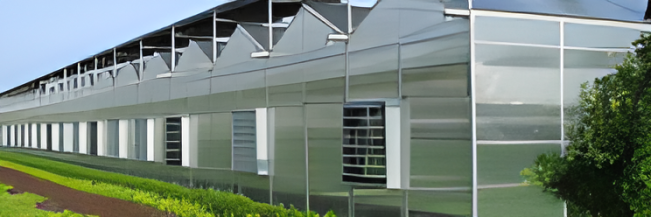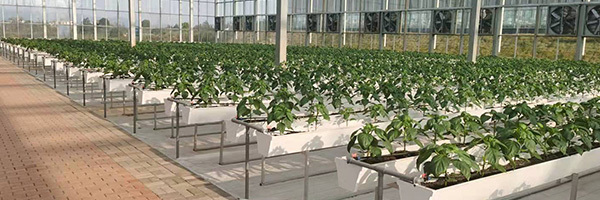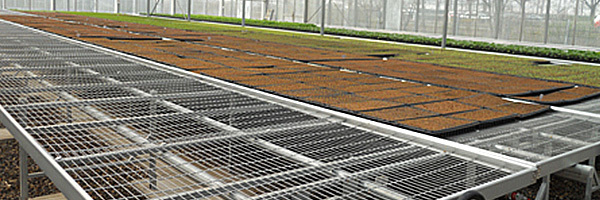-
-
Company Profile
-

Greenhouse Structures

-
Polycarbonate sheet greenhouse
-
Glass greenhouses
-
Multi-Span film greenhouse
-
Tunnel greenhouse
-
Sightseeing greenhouse
-
Double-film frame solar greenhouses
-
Glass and polycarbonate sheet greenhouses
-
Glass greenhouses structures suitable for planting
-
Glass Greenhouse for Scientific Research
View More -
-

-

Maximizing Light and Space: The Design of Glass Greenhouses for Research
Release time:
2025-10-14
Maximizing Light and Space: The Design of Glass Greenhouses for Research Glass greenhouses have transformed research in various fields, from botany to climatology. The ability to control environmental conditions while maximizing natural light makes these structures essential for scientific studies and agricultural innovation. In this article, we will explore the design principles, materials, and

Maximizing Light and Space: The Design of Glass Greenhouses for Research
Glass greenhouses have transformed research in various fields, from botany to climatology. The ability to control environmental conditions while maximizing natural light makes these structures essential for scientific studies and agricultural innovation. In this article, we will explore the design principles, materials, and technologies needed to create effective glass greenhouses that optimize light and space.
Table of Contents
- Understanding Glass Greenhouses
- Importance of Light in Research
- Design Principles for Glass Greenhouses
- Choosing the Right Materials for Construction
- Incorporating Technology in Greenhouse Design
- Maximizing Space in Glass Greenhouses
- Sustainability in Greenhouse Design
- Case Studies of Effective Glass Greenhouses
- FAQs About Glass Greenhouse Design
Understanding Glass Greenhouses
Glass greenhouses are specialized structures designed to provide a controlled environment for plants and research activities. Typically constructed with large panes of glass, these greenhouses allow maximum sunlight penetration while providing insulation against external temperatures. The transparent nature of glass enables researchers to observe growth patterns, conduct experiments, and monitor environmental conditions without interrupting the ecosystem within.
Types of Glass Greenhouses
There are several types of glass greenhouses tailored for specific research needs:
- Traditional Glass Greenhouses: These structures often consist of a frame made from aluminum or wood and are covered in single or double glazing glass panels.
- High-Tech Glass Greenhouses: Equipped with advanced climate control systems, these greenhouses optimize conditions for plant growth and research.
- Hydroponic Glass Greenhouses: Incorporating hydroponic systems, these structures minimize soil use and maximize plant productivity.
Importance of Light in Research
Light is a fundamental element in any greenhouse, especially glass structures. Plants rely on sunlight for photosynthesis, which is critical for their growth and development. Moreover, adequate light exposure plays a significant role in various research applications, including:
- Growth Rate Studies: Researchers can assess how different light levels influence plant growth rates and yield.
- Photosynthesis Research: Monitoring the effects of light quality and quantity on photosynthetic efficiency is crucial for understanding plant biology.
- Climate Resilience Studies: Observing how plants adapt to changing light conditions can inform strategies for climate resilience in agriculture.
Natural vs. Artificial Light
While natural light is crucial, integrating artificial lighting systems can enhance research capabilities. For example, LED grow lights can supplement sunlight during shorter days or cloudy weather, ensuring consistent light availability for plants.
Design Principles for Glass Greenhouses
Designing an effective glass greenhouse involves understanding how to maximize light and space while ensuring optimal growing conditions. Key design principles include:
Orientation and Location
The positioning of a greenhouse significantly impacts light exposure. Ideally, greenhouses should be oriented along an east-west axis to capture sunlight throughout the day. Additionally, selecting a location that minimizes shade from surrounding structures or trees is vital.
Ventilation and Airflow Design
Proper ventilation is crucial to maintaining temperature and humidity levels within the greenhouse. Designing for adequate airflow involves incorporating windows, vents, and fans strategically to facilitate natural air movement while preventing stagnant conditions that could harm plant health.
Thermal Mass Utilization
Utilizing materials with high thermal mass can help regulate temperature fluctuations within the greenhouse. For example, concrete or stone can absorb heat during the day and release it at night, creating a more stable growing environment.
Choosing the Right Materials for Construction
Selecting appropriate materials is crucial for the durability and effectiveness of a glass greenhouse. Key considerations include:
Glass Types
Different types of glass can be used in greenhouse construction, each offering unique benefits:
- Tempered Glass: Durable and resistant to breakage, tempered glass is ideal for greenhouses exposed to extreme weather conditions.
- Low-E Glass: This energy-efficient option minimizes heat loss and enhances light penetration, making it suitable for research applications.
- Polycarbonate Panels: While not glass, polycarbonate is a lightweight alternative offering excellent insulation and UV protection.
Structural Materials
The frame of the greenhouse can be constructed from various materials, including aluminum, steel, or wood. Each material has its pros and cons regarding durability, cost, and maintenance requirements.
Incorporating Technology in Greenhouse Design
Modern glass greenhouses benefit from technological advancements that enhance their functionality. Key technologies include:
Climate Control Systems
Automated climate control systems can monitor temperature, humidity, and light levels, adjusting them as needed to ensure optimal conditions for research. These systems can include sensors and software that provide real-time data to researchers.
Hydroponics and Aeroponics Systems
Integrating hydroponic or aeroponic systems allows for soil-less growing, which can lead to faster plant growth and higher yields. These systems require careful design considerations to ensure proper water and nutrient delivery.
Integrated Pest Management Technologies
Modern greenhouses can incorporate pest management technologies, such as biological control systems and sensors to detect pest populations. These technologies help maintain a healthy growing environment while minimizing chemical use.
Maximizing Space in Glass Greenhouses
Efficient use of space is critical in glass greenhouses, especially those used for research. Strategies to maximize space include:
Vertical Growing Techniques
Implementing vertical growing systems can increase plant density without sacrificing light exposure. Shelving units or hanging systems allow for more plants to grow within the same footprint.
Modular Design Approaches
Using a modular design allows for flexibility in the greenhouse layout, enabling researchers to adapt the space for different experiments or plant types as needed.
Sustainability in Greenhouse Design
Incorporating sustainable practices into the design and operation of glass greenhouses is becoming increasingly important. Key sustainability strategies include:
Energy Efficiency Measures
Implementing energy-efficient technologies, such as solar panels or geothermal heating systems, can reduce reliance on non-renewable energy sources, making greenhouses more sustainable.
Water Conservation Techniques
Using rainwater harvesting systems or recirculating irrigation methods can minimize water usage, making greenhouse operations more environmentally friendly.
Case Studies of Effective Glass Greenhouses
Examining successful glass greenhouse projects can provide valuable insights into best practices. Here are a few notable examples:
The Eden Project, UK
This iconic project features two biomes made of geodesic domes, showcasing a wide variety of plant species from different climates. The design emphasizes energy efficiency and sustainable practices.
University of Arizona’s Controlled Environment Agriculture Center
This research facility utilizes cutting-edge technology to study plant responses to various environmental conditions, maximizing space and light in its greenhouse design.
FAQs About Glass Greenhouse Design
What is the best type of glass for greenhouses?
Tempered glass and low-E glass are excellent choices due to their durability and energy efficiency.
How can I maximize light in a greenhouse?
Proper orientation, using clear glass, and employing reflective surfaces can enhance light penetration in a greenhouse.
What technologies should I consider for my greenhouse?
Consider climate control systems, hydroponic systems, and integrated pest management technologies for optimal efficiency.
How do I ensure proper ventilation in a greenhouse?
Incorporate windows, vents, and fans in the design to facilitate natural airflow and maintain optimal humidity levels.
What are some sustainable practices for greenhouses?
Implementing energy-efficient technologies, water conservation methods, and using sustainable materials can enhance a greenhouse's sustainability.
Conclusion
The design of glass greenhouses for research is a multifaceted discipline that encompasses various aspects of architecture, engineering, and environmental science. By maximizing light and space through thoughtful design, material selection, and technological integration, researchers can create optimal conditions for study and experimentation. As sustainability becomes increasingly important in all fields, adopting eco-friendly practices will ensure that these greenhouses not only serve their immediate purpose but also contribute positively to the environment. Embracing these principles will lead to enhanced research capabilities and foster innovation in various scientific disciplines.
Keyword:
Related News
Maximizing Light and Space: The Design of Glass Greenhouses for Research
Maximizing Light and Space: The Design of Glass Greenhouses for Research Glass greenhouses have transformed research in various fields, from botany to climatology. The ability to control environmental conditions while maximizing natural light makes these structures essential for scientific studies and agricultural innovation. In this article, we will explore the design principles, materials, and
2025-10-14
The Benefits and Considerations of Glass Greenhouses in Architectural Design
--- Glass greenhouses have become increasingly popular in the field of architecture and construction, particularly within the niche of building materials. These structures serve as a unique intersection of functionality and aesthetic appeal, making them an attractive option for various applications, from residential gardens to commercial spaces. One of the primary benefits of a glass greenhouse is
2025-10-09
Enhancing Eco-Friendliness with Glass and Polycarbonate Greenhouses Table of Contents Introduction to Eco-Friendly Greenhouses Benefits of Glass and Polycarbonate Greenhouses Glass vs. Polycarbonate: Which is Better? Sustainability in Agricultural Practices Energy Efficiency in Greenhouses Environmental Impact of Greenhouses Best Practices for Eco-Friendly Greenhouse M
2025-10-04
Exploring the Benefits and Features of Greenhouse Glass Roofs
Greenhouse glass roofs are becoming increasingly popular in the construction and decoration materials industry, particularly among horticulturists and eco-conscious builders. These roofs not only enhance the aesthetic appeal of greenhouses but also offer numerous functional benefits that contribute to a healthier growing environment for plants. One of the primary advantages of greenhouse glass ro
2025-09-29
How Glass Greenhouses Revolutionize Planting Techniques for Modern Agriculture
How Glass Greenhouses Revolutionize Planting Techniques for Modern Agriculture Table of Contents 1. Introduction to Glass Greenhouses 2. Benefits of Glass Greenhouses in Agriculture 3. Design and Structure of Glass Greenhouses 4. Climate Control: The Heart of Glass Greenhouses 5. Sustainability Practices in Glass Greenhouses 6. Impact on Crop Yield and Quality 7. Case
2025-09-24
Contact
Address: Hebei University of Technology Science and Technology Park, High tech Zone, Cangzhou City, Hebei Province
International Trade Office: Huashang Building, Yunhe District, Cangzhou City (500 meters east of Cangzhou West High speed Railway Station)
Tel:+86 15301369860

Online message
-







